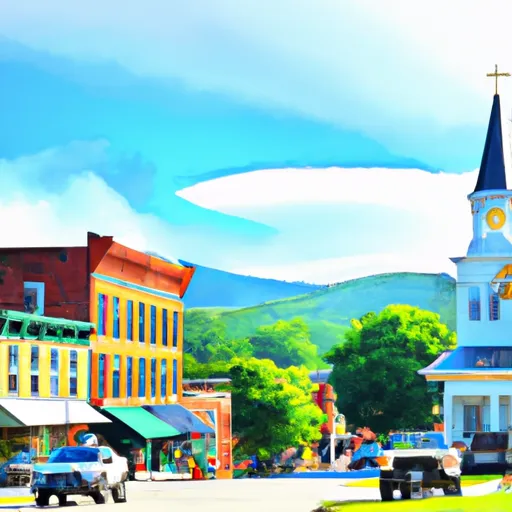-
 Snoflo Premium
Snoflo Premium
Get unlimited access to all our content
With no Ad interruptions! - Start Your Free Trial Login with existing account
Manchester
Eden Index
Climate
7.7
•
Recreation
4.8
•
Community
1.1
•
Safeguard
5.0/10

Manchester, Vermont, nestled in the heart of the Green Mountains, offers a picturesque and vibrant setting for outdoor enthusiasts. The town experiences a humid continental climate, characterized by warm summers and cold winters. With an average annual temperature of 47°F (8°C), Manchester enjoys a diverse range of recreational opportunities in every season.
Hydrologically, the Batten Kill River flows through Manchester, offering excellent fishing opportunities for trout enthusiasts. Additionally, the town boasts several pristine lakes and ponds for swimming, boating, and paddling. Outdoor enthusiasts can also explore the numerous hiking trails that wind through the surrounding mountains, including the famous Appalachian Trail.
Manchester's natural beauty and climate make it an ideal destination for outdoor recreation. In the summer, visitors can enjoy golfing, horseback riding, and mountain biking. As autumn arrives, the breathtaking fall foliage attracts visitors from far and wide. Winter brings opportunities for skiing and snowboarding at nearby resorts, as well as snowshoeing and cross-country skiing on the town's trails.
Overall, Manchester, Vermont offers a year-round playground for nature lovers, with its diverse climate, hydrology constituents, and abundant outdoor recreation opportunities.
What is the Eden Index?
The Snoflo Eden Index serves as a comprehensive rating system for regions, evaluating their desirability through a holistic assessment of climate health, outdoor recreation opportunities, and natural disaster risk, acknowledging the profound impact of these factors on livability and well-being.
Climate Health Indicator (CHI): 7.7
Manchester receives approximately
1292mm of rain per year,
with humidity levels near 78%
and air temperatures averaging around
7°C.
Manchester has a plant hardyness factor of
5, meaning
plants and agriculture in this region thrive during a short period during spring and early summer. Most
plants will die off during the colder winter months.
By considering the ideal temperature range, reliable water supplies, clean air, and stable seasonal rain or snowpacks, the Climate Health Indicator (CHI) underscores the significance of a healthy climate as the foundation for quality living.
A healthy climate is paramount for ensuring a high quality of life and livability in a region, fostering both physical well-being and environmental harmony. This can be characterized by ideal temperatures, reliable access to water supplies, clean air, and consistent seasonal rain or snowpacks.
Weather Forecast
Streamflow Conditions
Upper Hudson
Area Rivers
Upper Hudson
Snowpack Depths
Upper Hudson
Reservoir Storage Capacity
Upper Hudson
Groundwater Levels
Recreational Opportunity Index (ROI): 4.8
The Recreational Opportunity Index (ROI) recognizes the value of outdoor recreational options, such as parks, hiking trails, camping sites, and fishing spots, while acknowledging that climate plays a pivotal role in ensuring the comfort and consistency of these experiences.
Access to outdoor recreational opportunities, encompassing activities such as parks, hiking, camping, and fishing, is crucial for overall well-being, and the climate plays a pivotal role in enabling and enhancing these experiences, ensuring that individuals can engage in nature-based activities comfortably and consistently.
Camping Areas
| Campground | Campsites | Reservations | Toilets | Showers | Elevation |
|---|---|---|---|---|---|
| Grout Pond | None | 2,303 ft | |||
| Hapgood Pond | 28 | 1,548 ft | |||
| Mt. Greylock State Reservation | 35 | 2,411 ft | |||
| Historic Valley | 114 | 952 ft | |||
| Mohawk Trail State Forest | 56 | 762 ft | |||
| Red Mill Brook | 31 | 2,178 ft | |||
| Savoy Mountain State Forest | 45 | 1,989 ft | |||
| Windsor State Forest | 24 | 1,845 ft | |||
| Clarksburg State Park | 45 | 1,111 ft | |||
| Woodford State Park | 100 | 2,367 ft |
Nearby Fishing
Nearby Ski Areas
Catastrophe Safeguard Index (CSI):
The Catastrophe Safeguard Index (CSI) recognizes that natural disaster risk, encompassing floods, fires, hurricanes, and tornadoes, can drastically affect safety and the overall appeal of an area.
The level of natural disaster risk in a region significantly affects safety and the overall livability, with climate change amplifying these risks by potentially increasing the frequency and intensity of events like floods, fires, hurricanes, and tornadoes, thereby posing substantial challenges to community resilience and well-being.
Community Resilience Indicator (CRI): 1.1
The Community Resilience Indicator (CRI) recognizes that education, healthcare, and socioeconomics are crucial to the well-being of a region. The CRI acknowledges the profound impact of these elements on residents' overall quality of life. By evaluating educational resources, healthcare accessibility, and economic inclusivity, the index captures the essential aspects that contribute to a thriving community, fostering resident satisfaction, equity, and social cohesion.

